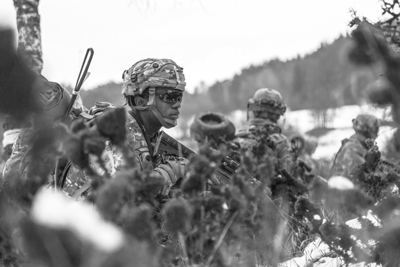A patrol is sent out by a larger unit to conduct a specific combat, reconnaissance, or security mission. A patrol’s organization is temporary and specifically matched to the immediate task. Because a patrol is an organization, not a mission, it is not correct to speak of giving a unit a mission to “Patrol.”
The two categories of patrols are combat and reconnaissance. Regardless of the type of patrol being sent out, the commander must provide a clear task and purpose to the patrol leader. Any time a patrol leaves the main body of the unit there is a possibility that it may become engaged in close combat.

Patrol missions can range from security patrols in the close vicinity of the main body, to raids deep into enemy territory. Successful patrolling requires detailed contingency planning and well-rehearsed small unit tactics. The planned action determines the type of patrol.
Combat Patrols
Patrols that depart the main body with the clear intent to make direct contact with the enemy are called combat patrols. The three types of combat patrols are raid patrols, ambush patrols (both of which are sent out to conduct special purpose attacks), and security patrols.
Reconnaissance Patrols
Patrols that depart the main body with the intention of avoiding direct combat with the enemy while seeing out information or confirming the accuracy of previously-gathered information are called reconnaissance patrols. The most common types reconnaissance patrols are area, route, zone, and point. Leaders also dispatch reconnaissance patrols to track the enemy, and to establish contact with other friendly forces. Contact patrols make physical contact with adjacent units and report their location, status, and intentions. Tracking patrols follow the trail and movements of a specific enemy unit. Presence patrols conduct a special form of reconnaissance, normally during stability or civil support operations.
 This article is an extract from "SUTS3: The Small Unit Tactics SMARTbook, 3rd Ed. (Planning & Conducting Tactical Operations)" by The Lightning Press. Download a free PDF sample and learn more at: SUTS3: The Small Unit Tactics SMARTbook, 3rd Ed. (Planning & Conducting Tactical Operations).
This article is an extract from "SUTS3: The Small Unit Tactics SMARTbook, 3rd Ed. (Planning & Conducting Tactical Operations)" by The Lightning Press. Download a free PDF sample and learn more at: SUTS3: The Small Unit Tactics SMARTbook, 3rd Ed. (Planning & Conducting Tactical Operations).
Browse additional military doctrine articles in our SMARTnews Blog & Resource Center.
About The Lightning Press SMARTbooks. Recognized as a “whole of government” doctrinal reference standard by military, national security and government professionals around the world, SMARTbooks comprise a comprehensive professional library. SMARTbooks can be used as quick reference guides during operations, as study guides at education and professional development courses, and as lesson plans and checklists in support of training. Browse our collection of Military Reference SMARTbooks to learn more.













































